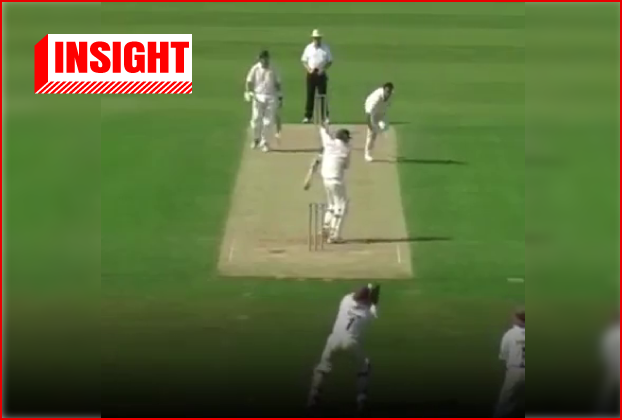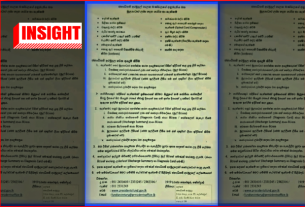Cricket, renowned for its inherent unpredictability, occasionally gets highlighted for bizarre umpiring blunders. In this sport, where split-second judgments can sway the course of a match, the reliability of umpires’ decisions is paramount. A recent viral video featured such a strange, umpiring decision that baffled many.
Viral Social Media Posts
This investigation aims to delve into the circumstances surrounding the contentious call, shedding light on the complexities of officiating in cricket and addressing any concerns raised by the incident.
The video shows a batsman leading a ball alone, and his bat is evidently nowhere close to the ball. However, even without any clear appeals from the fielding side, the umpire raises his finger, signalling that the batsman is ‘out’. The batsman also walks off without much hesitation, and this decision left many, including cricketing pundits, puzzled as to what could have been the reason for the umpire to declare the batsman as ‘out’.
This video went viral on WhatsApp, too.

We decided to investigate the reasons behind this strange mode of dismissal.
Explanation
In the annals of cricket history, certain incidents stand out not just for their sporting significance but for their sheer peculiarity. This is one such incident that occurred during a match between Surrey and Leeds/Bradford UCCE at The Oval in 2007, where a dismissal left spectators scratching their heads and sparked debates that would echo through the cricketing community for years to come.
The person at the centre of this cricketing enigma was identified as Tom Merilaht, a batsman for Leeds/Bradford UCCE, whose dismissal on that fateful day remains etched in the memories of those who witnessed it, to the bowling of Surrey’s Mohammad Akram.
The incident itself is shrouded in mystery, with various theories attempting to explain the baffling sequence of events.
One theory suggests that Merilaht had been dismissed hit-wicket off the last ball of the previous over, but the umpire failed to notice, thus allowing play to continue. However, this theory fails to hold water, as the fielding side could have still appealed the dismissal had it occurred in the preceding over.
Another theory posits that the match was being played under unusual circumstances, perhaps as a charity game with unconventional rules. However, it was confirmed that the match adhered to the regulations set forth by the England and Wales Cricket Board (ECB) for first-class matches, dispelling any notion of unconventional rules governing the game.
To add to the intrigue, eyewitness accounts from players involved in the match provide conflicting narratives.
Rikki Clarke, who was captaining Surrey at the time, acknowledged that there was a noise, and two players appealed for the dismissal but described it as a “shocker” of a decision.
Merilaht himself, when asked about the incident, humorously remarked that he was “on for Lara’s 501 that innings too,” alluding to Brian Lara’s record-breaking innings, and admitted that he hadn’t walked off the pitch so promptly since. More Details about it can be read here. Archived
Perhaps the most curious aspect of the incident is Merilaht’s reaction, or lack thereof, to the umpire’s decision. Despite the surprising judgment, the batsman accepted the decision without protest and promptly marched off the pitch, leaving spectators and commentators alike bewildered by his seemingly unquestioning compliance.
In the years that followed, the incident faded from memory, only to resurface nearly a decade later when a video of the dismissal went viral on social media platforms after Indian all-rounder Yuvraj Singh tweeted the bizarre video. Twitter users took to tagging Merilaht, seeking answers to the mystery that had captivated cricket fans years earlier. In response, Merilaht offered a series of witty retorts, suggesting that the umpire may have been seeing double or even intoxicated. More details about it can be read here. Archived
Despite the renewed interest in the incident, the umpire at the centre of the controversy, Martin Bodenham, a former football referee turned cricket umpire, has remained silent on the matter, offering no public comment or explanation.
“The umpire in that game was inexperienced and had just turned down two vociferous appeals that put him under pressure,” Mohammed Akram told the media. “Then that delivery was nowhere near the bat, and we didn’t appeal either, except for a half-hearted try by the slip fielder. Much to our surprise, he gave him out even though there was no chance in hell he had nicked it,” Akram stated. “I was actually going back to bowl the next ball when the finger got raised,” he continued. “Surprisingly, the batsman didn’t protest either and promptly accepted the decision.” Akram’s comments add weight to the investigation, raising concerns about the umpire’s decision-making process and its potential impact on the game. More details about it can be read here. Archived
In the annals of cricketing history, the dismissal of Tom Merilaht stands as a testament to the unpredictable nature of the sport. Whether it was a case of human error, misjudgment, or simply a bizarre twist of fate, one thing remains certain: the mystery of Merilaht’s dismissal will continue to intrigue and perplex cricket fans for years to come.
With a Sri Lankan batsman being ‘timed out’ in one of the 2023 ODI World Cup games, the strange modes of dismissals again became prominent, especially highlighting the less frequent forms, as seen here. Also, here are the modes of dismissals in cricket as listed by MCC.
Follow us and stay up to date with our latest fact checks.
Facebook | Twitter | Instagram | Google News | TikTok

Title:The Curious Case of Tom Merilaht: Unraveling the Mystery Behind a Bizarre Cricket Dismissal
Fact Check By: Kalana KrishanthaResult: Insight






